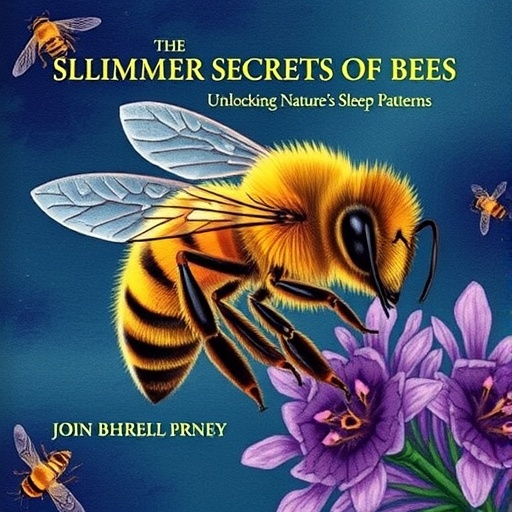In the intricate dance of life, bees often symbolize the delicate balance and interdependence within our ecosystems. These tiny pollinators not only facilitate plant reproduction but also underpin global biodiversity and agricultural productivity. Yet, despite their ecological significance, many aspects of their biology remain a mystery. A groundbreaking study from the University of Trento now illuminates one such enigma: the nature of sleep in honey bees and how their neuronal processes during rest bear striking resemblance to those of humans.
By harnessing two-photon microscopy, a technique allowing imaging of live neuronal activity with exceptional spatial resolution, the researchers embarked on observing the sleeping bee’s brain in real time. They focused predominantly on the antennal lobes — the primary olfactory centers responsible for processing smell. Since olfaction is a critical sense for bees navigating their environment, understanding how these circuits operate during sleep could unveil fundamental principles of neural information processing.
During the nocturnal hours, when bees entered their natural sleep state, their brain activity and body movements were concurrently recorded. The team employed a front-facing camera to monitor subtle physical states while simultaneously capturing fluctuations in calcium concentrations within neurons, an established proxy for neuronal firing. This dual monitoring allowed a comprehensive correlational analysis between behavioral quiescence and brain dynamics.
One of the study’s paramount discoveries was that during rest, bee brain networks transition into a synchronized mode characterized by reduced information processing. This state parallels the diminished sensory responsiveness observed in mammalian sleep, hinting at conserved neurophysiological strategies across distant species. Such synchronization points to a prioritization of internal neural processes, possibly linked to memory consolidation or restorative functions.
Building upon these empirical observations, the researchers developed computational neural models to simulate and probe the underlying mechanisms. The simulations revealed that modulating synaptic coupling — the strength of connections between neurons — fundamentally shifted the brain’s ability to decode external odor signals. Reduced synaptic coupling during sleep impaired olfactory perception, matching the behavioral attenuation seen in sleeping animals. This computational insight links microscopic synaptic adjustments directly to macroscopic sensory outcomes.
These findings carry profound implications beyond neuroscience. Given the ecological prominence of honey bees, understanding how sleep modulates their sensory systems offers a window into how environmental stressors might disrupt these vital processes. Factors such as pesticide exposure, habitat loss, and climate change could conceivably perturb sleep architecture, leading to impaired foraging behavior, cognitive deficits, and ultimately, colony collapse.
Moreover, the study’s revelation that bee sleep shares neurophysiological signatures with human sleep opens exciting avenues for biomedical research. Unlike humans, where direct examination of individual neuron activity during sleep is constrained, bees present an accessible model to dissect sleep at the cellular level. Insights gleaned could inform our understanding of memory consolidation, sensory gating, and even sleep disorders.
Intriguingly, bees use sleep to consolidate cognitive maps essential for navigating complex environments during foraging. The stabilization and enhancement of spatial memories during rest underscore the functional relevance of sleep in insect cognition. Investigating these processes at a neuronal level might elucidate universal principles governing memory across species.
Technologically, this research exemplifies the power of integrating cutting-edge imaging modalities with machine learning algorithms and biophysical modeling. The automated data collection during the bees’ nocturnal sleep phase ensured objective, high-throughput analyses, overcoming traditional limitations in insect neuroscience.
The interdisciplinary nature of the team — encompassing neurobiology, computational neuroscience, bioinformatics, and physics — was instrumental in achieving such comprehensive insights. Their collective expertise fostered novel methodologies capable of bridging microscopic neuronal phenomena with holistic behavioral states.
As we face a growing global concern over pollinator health, these foundational insights into sleep mechanisms may guide mitigation strategies. By delineating how sleep shapes sensory processing and resilience in bees, conservation efforts can be better informed to safeguard these indispensable pollinators.
Looking forward, this research sets the stage for exploring how pathological conditions or anthropogenic challenges interfere with sleep architecture in bees. Experimental paradigms may interrogate how toxins or climate-induced stressors alter brain network dynamics during rest, thereby affecting survival and ecological function.
In conclusion, sleep in honey bees emerges not merely as a quiescent state but as a dynamically regulated process sharing core characteristics with mammalian sleep. This convergence reflects evolutionary continuity and underscores the value of cross-species investigations in unraveling complex brain functions. With each neuronal signature decoded, we move closer to understanding the profound mysteries enshrouding sleep, cognition, and survival in the natural world.
Subject of Research: Animals
Article Title: Neuronal correlates of sleep in honey bees
News Publication Date: 11-May-2025
Web References: 10.1016/j.neunet.2025.107575
References: Haase A., Moguilner S., Tiraboschi E., Fantoni G., Strelevitz H., Soleimani H., Del Torre L., Hasson U. (2025). Neuronal correlates of sleep in honey bees. Neural Networks. DOI: 10.1016/j.neunet.2025.107575
Keywords: honey bees, sleep, neuronal activity, antennal lobes, olfaction, two-photon microscopy, computational modeling, sensory processing, pollinator health, memory consolidation, synaptic coupling, neural networks
Tags: advanced imaging techniques in biologybees sleep patterns researchbiodiversity and pollinationcomputational modeling in neuroscienceecological significance of beesevolutionary biology of sleephoney bee neuroscienceinterdisciplinary studies on beesneural mechanisms of sleepolfactory processing in beessleep similarities in humans and beestwo-photon microscopy applications





